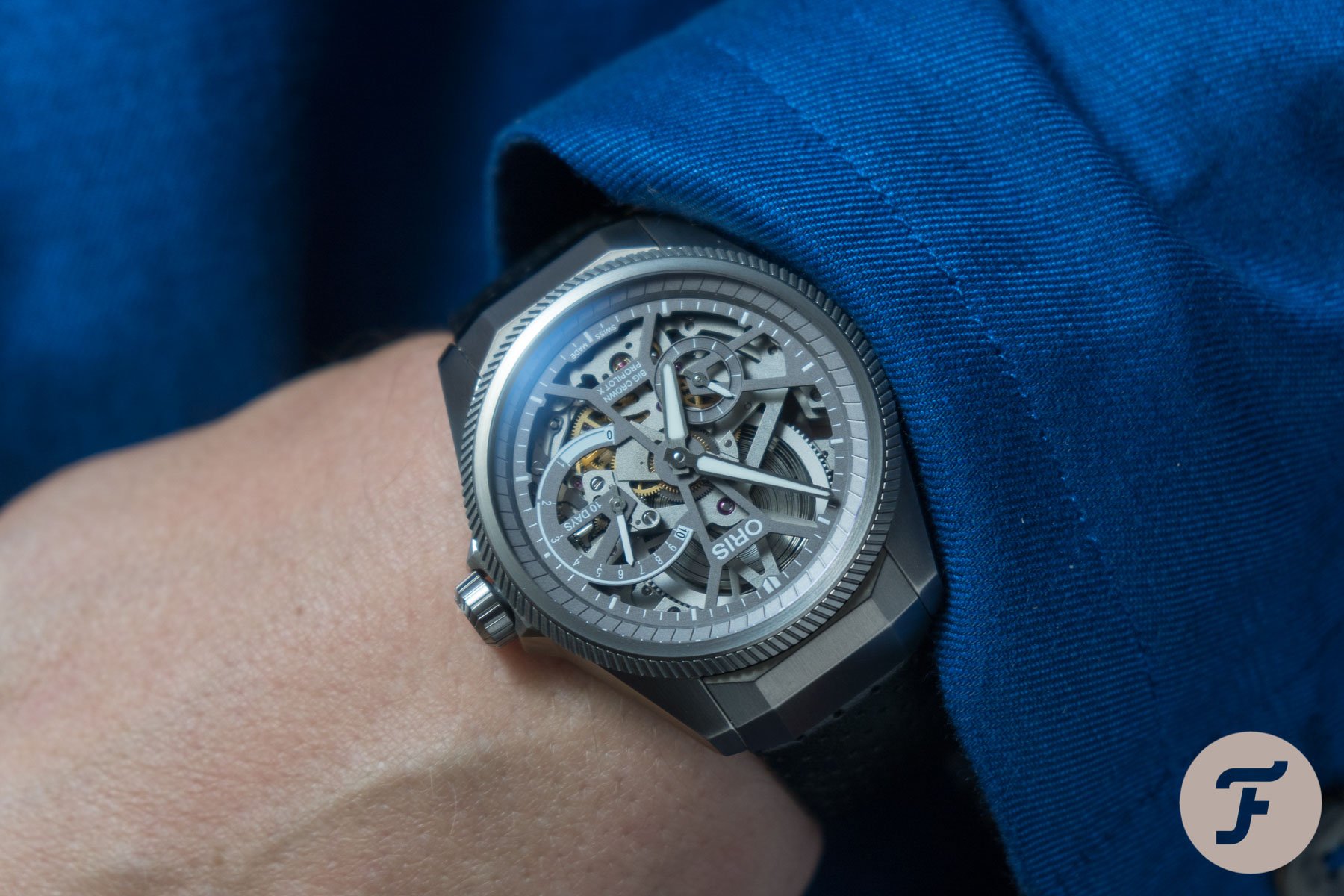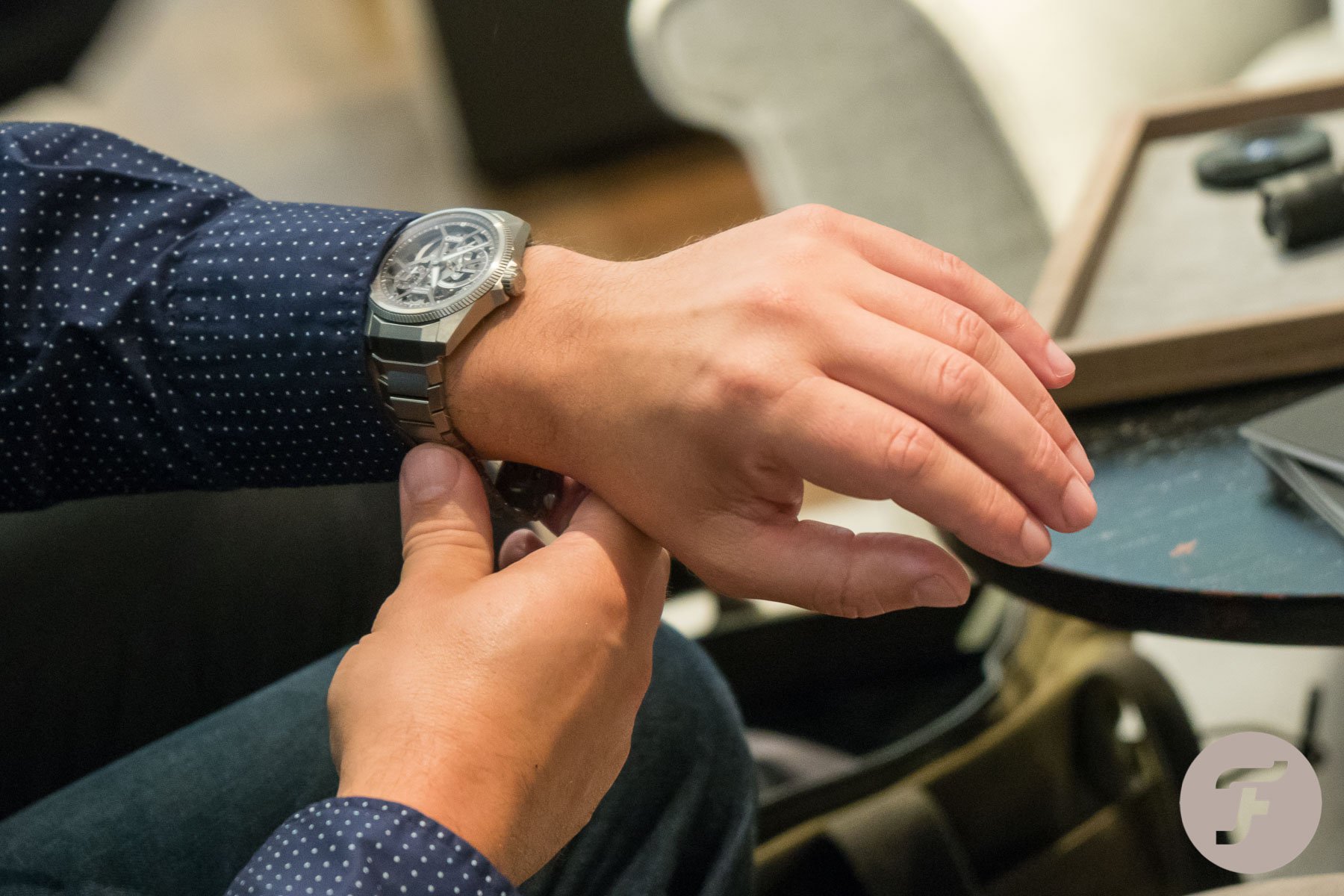Hands-On Oris Big Crown ProPilot X Calibre 115 Review
Oris’ new Big Crown ProPilot X Calibre 115 has been a surprise. Not that no one believed Oris could make such a watch, but virtually nobody expected it. With this watch, Oris proudly expose their ability to create extraordinary movements. Besides, they present a strong statement on their vision of the design for a future pilot watch. Fasten seat belts and let’s lift-off to an exploration of this remarkable timepiece.
In 2014 Oris reverted to manufacturing own movements. After a break of decades, they celebrated their re-establishment as manufacture by creating Calibre 110, a watch named after its movement, whose name, in turn, reflects Oris’ 110th anniversary at which they presented it to the public. The most prominent feature of this movement, apart from being manufactured in-house, is its outstanding power reserve of 10 days, which is indicated on a non-linear scale. If you are not familiar with Oris’ recent history you may head to an article our RJ wrote on the Calibre 110’s successor, the Calibre 111. Each year since then, Oris presents a new iteration of this in-house movement, integrating different complications into the base movement.
When you count correctly, you see that 2019 is the year of Calibre 115. This time Oris, instead of adding another complication, turns to an entirely new direction by presenting a skeletonised version of their base movement. Oris already offers watches with skeletonised movements in their Artelier and Artix GT collections, but for those watches, they use calibres from ETA and Sellita.
The other outstanding characteristic of the Big Crown ProPilot X is the bold, modern case in grey titanium, which is complemented by an entirely new designed bracelet with an unusual folding clasp. Other models in the Big Crown ProPilot family of watches possess similar cases, but none of those cases contains all the design details the ProPilot X offers, and none of those has such a unique bracelet.
The successful combination of this movement and this case result in a decidedly technical watch, which captures your attention.
Calibre 115
When you look at the ProPilot X, what you see is its movement. The whole watch is designed around this eye-catcher. In contrary to the traditional approach of skeletonising, where a normal movement is adapted by cutting away more and more sections from its bridges and plates, Calibre 115 has been designed as a skeletonised movement right from the start. Therefore I would prefer to call it an open-worked movement (am I the only one who perceives an uncomfortable connotation in the term “skeletonising”?).
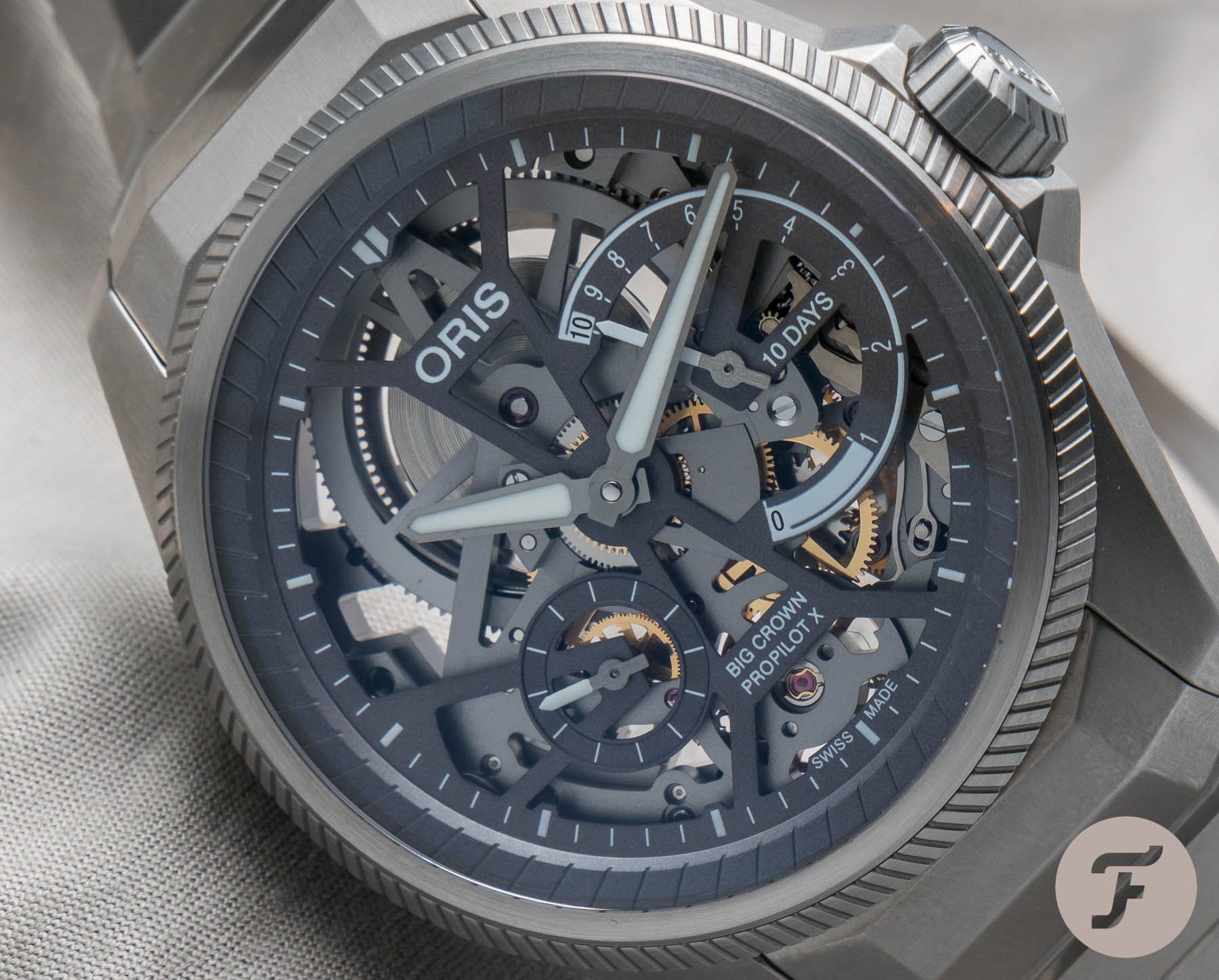
Different layers of bridges in this movement are coloured in varying hues of grey to differentiate them further, which increases the perceived depth. Even without this colour-coding trick, this movement exposes an impressive three-dimensionality. When you look at the (non-existent) dial from a flat angle from the 6 o’clock position (i. e. while the watch is on your wrist), the gap between the hands and the barrel between 9 and 11 appears gigantic. As the watch is rather thin and this gap can impossibly be as large as is looks, this can only be caused by the crystal, which is slightly domed on both sides. Altogether a rather smart design!
Those layers of this movement, which are most prominent because they are coloured in the brightest colour (white) are the hands, the indexes, and the barrel. The barrel is the main attraction of this movement. To reveal the barrel and its function has been the fundamental cause of creating an open-worked version of Oris’ in-house movement. And this barrel is impressive in its size and, because the barrel case is opened, even allows you to observe how you are winding it via the crown. Facilitating appropriate legibility of the time is an aspect which all too often is neglected in watches with skeletonised movements. In the ProPilot X, this legibility is even enhanced by luminous coating on the hands and the indexes. Yes, even the tiny hour indexes at the rim of the dial are luminous.
In natural daylight, the different colour shadings of the movement’s parts work best. The few brass-coloured gears you can see in the movement from the front also stand out more in natural light, without impairing the overall grey appearance of the whole watch, but intensifying the technical look.
The rear side of Calibre 115 also is an impressive sight, which is dominated by the huge (in terms of watch movements) barrel and a relatively small balance. Different layers of bridges and tiny gears cover the rest of the visible surface. A significant detail, which is revealed by the rear view of Calibre 115 between 8 and 9 o’clock (or between 3 and 4 when viewed from the front), is the mechanism that controls the non-linear power reserve indicator. You can see the two snail-shaped gears that drive the non-linear progression of the hand in the power reserve indicator.
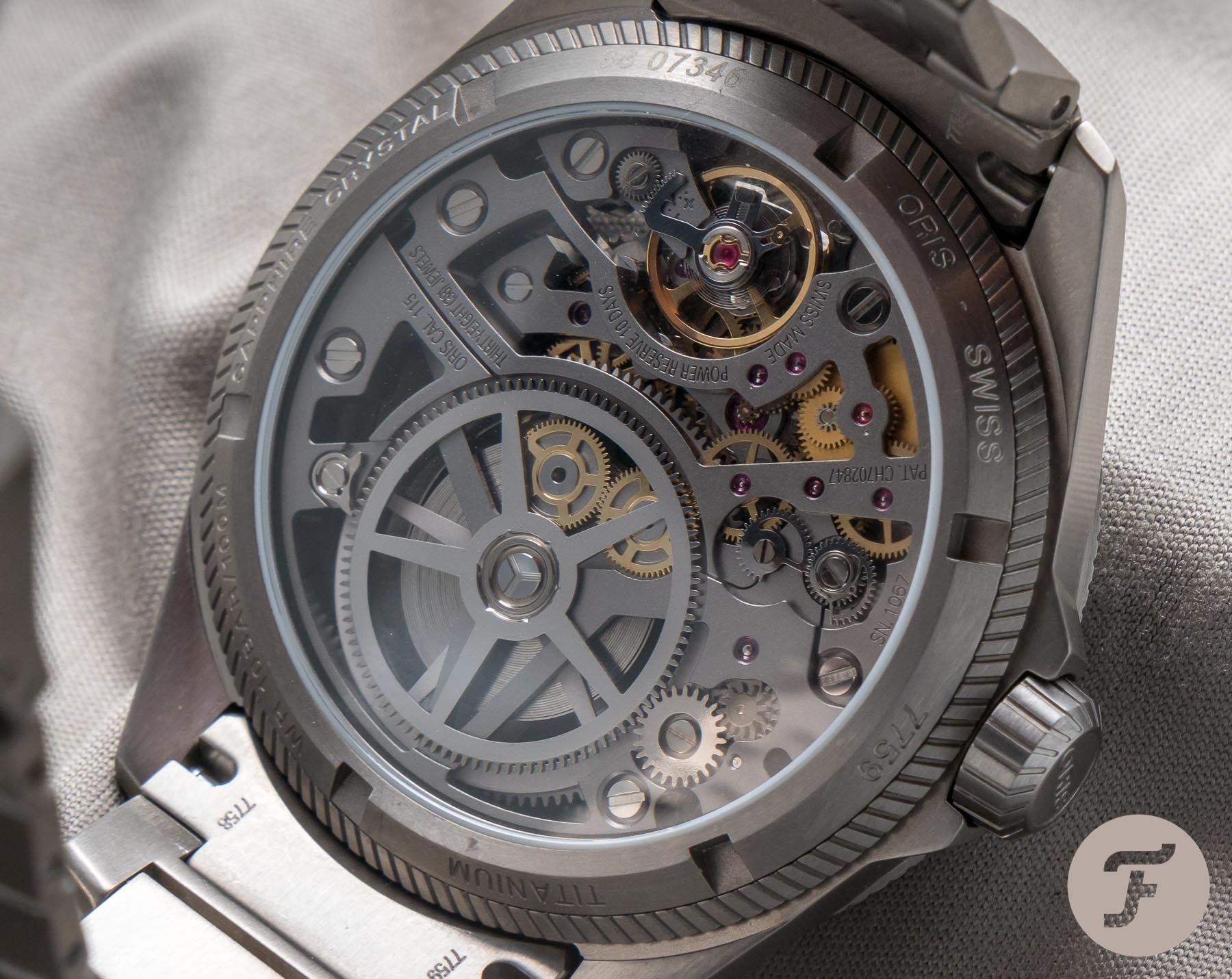
When holding the watch up against the light, you can look through the watch. When the watch is on your wrist, you can see a silver surface at the bottom through the openings of the movement.
Finishing
Examining Calibre 115 closely, you discover the somehow unfinished look of the fragile struts formed by the skeletonised bridges. All parts are meticulously deburred and present an evenly fine-grained surface. All these parts are sand-blasted to create that particular matt finish. So there obviously is a finishing applied to these parts, but it is not the traditional kind of finish consisting of chamfered edges and decoratively polished surfaces. While certainly limiting the costs to produce this movement, this type of alternative finishing effectively supports a modern technical look matching the appearance of the complete watch. Moreover, the absence of decorations prevents any distraction from functional aspects to support the main objective of this design, which consists in disclosing the functionality of this movement.
At several spots, where openings reach through the complete movement, you can look through the entire watch – one of the features of a skeletonised movement. The downside of this feature is that you can see your wrist through the watch while wearing it, which is not very pleasant. But this is not the case with the ProPilot X. When holding the watch up against the light, you can look through the watch. When the watch is on your wrist, you can see a silver surface at the bottom through the openings of the movement. Oris has coated the inside of the rear crystal with silvering. This layer allows light coming from the rear to transmit the rear crystal. But if the back of the watch is covered (by one’s wrist), this layer reflects like a mirror. That’s ingenious!
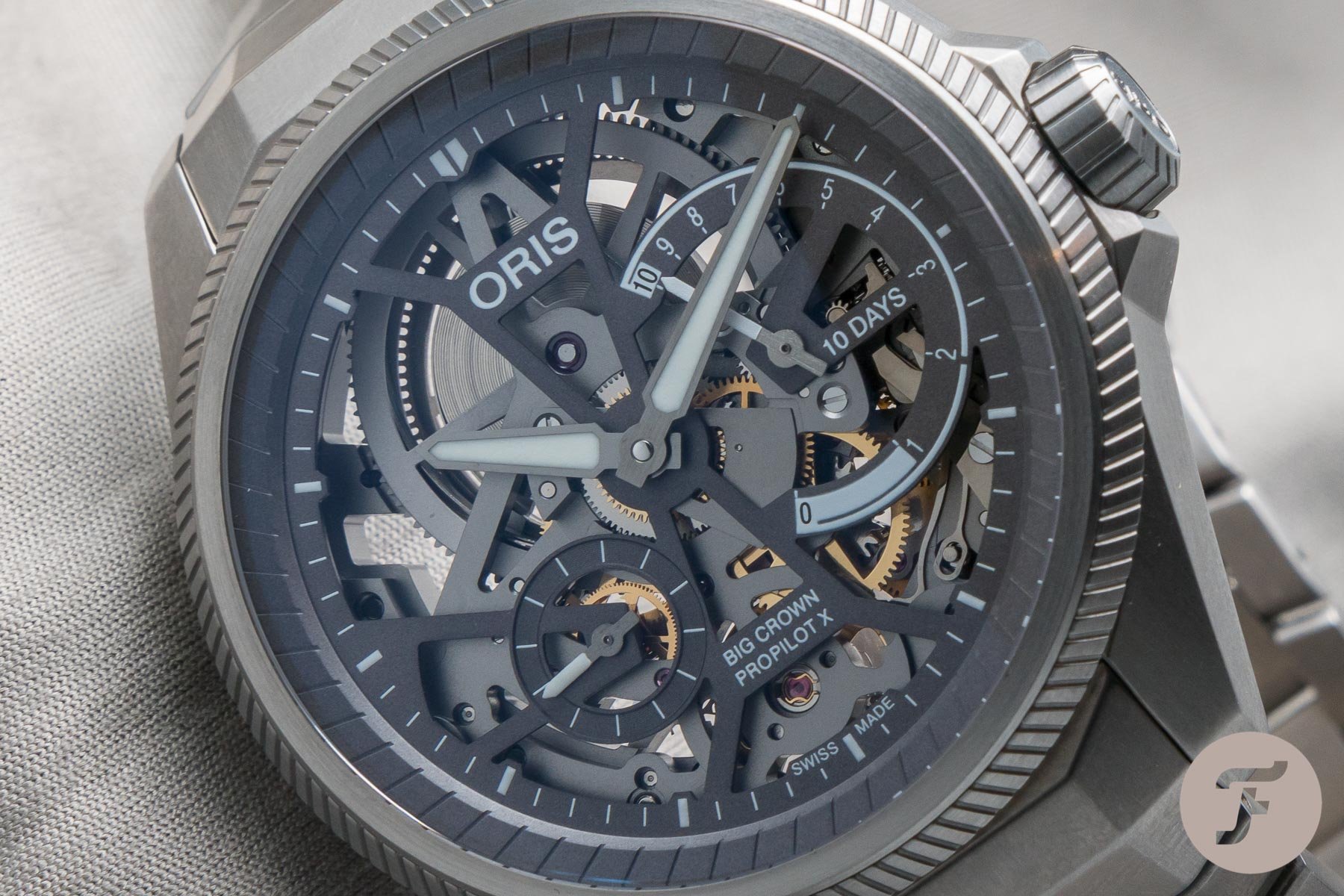
Operating Calibre 115
When you loosen the screwed-in crown and pull it out to set the time you notice that there are three positions. Position zero (pushed in) is for winding, and position two (pulled out completely) is for setting the time. Position one (the middle position between the other two positions) has no particular function. Usually, this centre position is reserved for the quick-setting of a date, but, as this movement doesn’t indicate a date, it has no function. This functionality is a minor design flaw, but one that you will hardly notice. Probably the same mechanism is used for all movements in Oris’ 110 family, regardless of whether they possess a date or not, to reduce costs.
When winding the movement, which is a considerable task for this extra-long mainspring, you detect a friction clutch like in an automatic movement that prevents you from overwinding (and breaking) the mainspring. As all existing variants in the 110 families of movements are hand-wound movements, this seems to be a security measure to protect the mainspring against the less sensitive among us.
Case and bracelet
At a diameter of 44mm, the ProPilot X is big. And it looks like that. If worn on a small wrist, it could look awkward. But the case is comparably thin (12.5mm), and the ProPilot X is one of those watches that comfortably nestle to your wrist. The usage of titanium as a material for the complete case and bracelet results in a watch that is much lighter than it looks. Some don’t like titanium watches because they lack the feeling of something substantial on their wrist. The ProPilot X is no hefty chunk on your arm, but you notice it’s there. And I love titanium! It’s light (yes, that can be a desirable property); it’s anti-corrosive, anti-allergic (not that I would have problems with steel), and scratches on it naturally heal by themselves through oxidation. And on top, it exposes that cool grey look. Again, I love titanium!
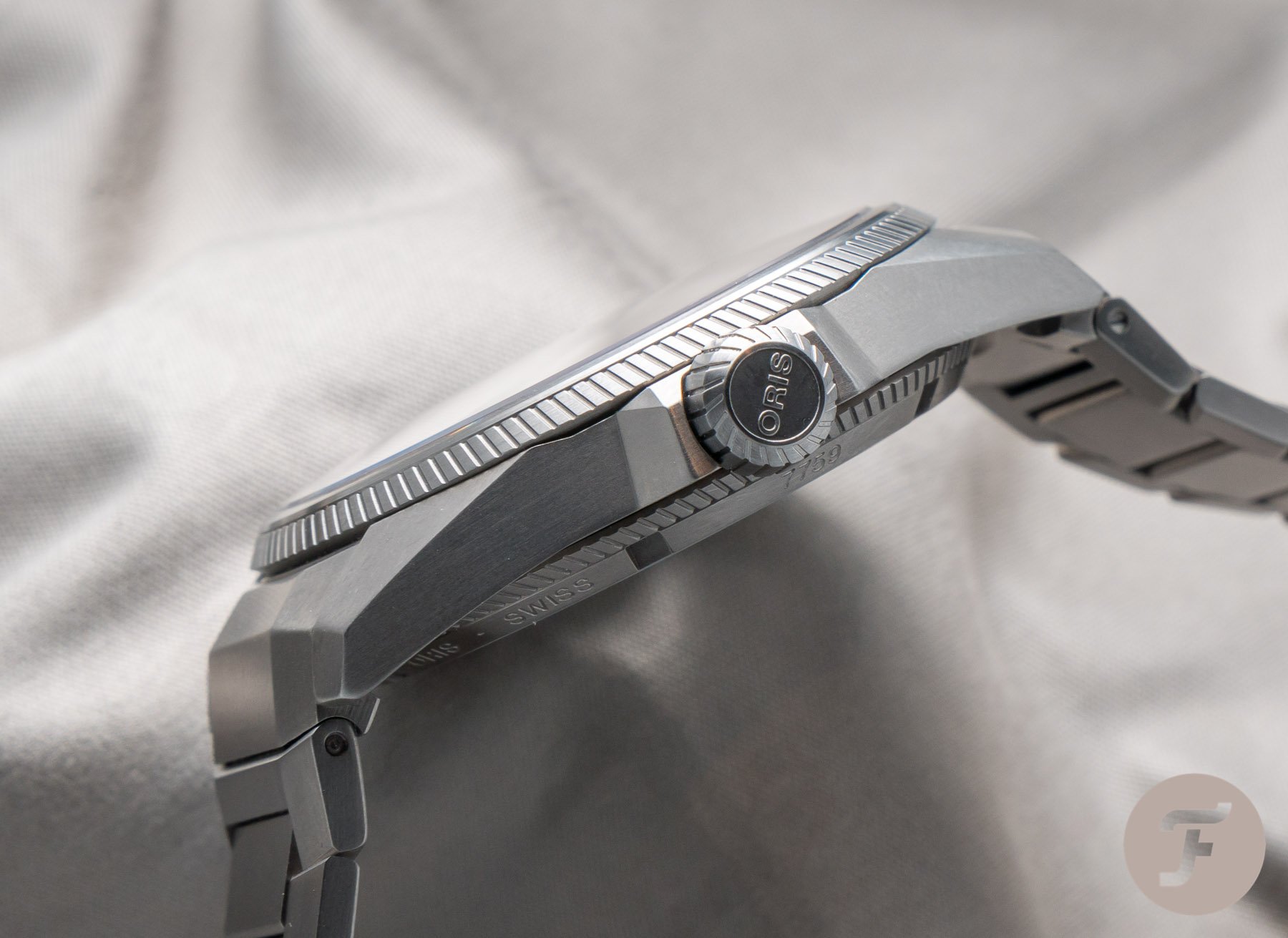
On the ProPilot X, the cool and technical look is emphasised by a slightly brushed surface. Only at certain viewing angles, you can see the marks caused by the brushing as thin parallel lines. Just enough surface treatment is applied to let that surface appear slightly matt. And it is the same impression on every part of the case and bracelet. Some might miss the combination of shiny and matt surfaces that enhance the appearance of many watches. Here, like in the movement, keeping things reduced serves the purpose of not interfere with the functional image of the movement. The star of this watch is the movement, and the case serves it as its stage. And it does that well.
But this doesn’t mean that there wouldn’t exist several design details that elicit a smile on a connoisseur’s face. The bezel identifies the ProPilot X as a member of Oris’ Big Crown ProPilot collection. The decoration pattern of diagonal lines that imitate the impression of turbine blades in a turbojet engine also adorns several other watches of that family. On the ProPilot X, a similar decoration on the rehaut complements this design to direct the attention to the movement. The flat ring between these two decorations around the dial prevents those from appearing obtrusive.
The lugs look strong when viewed from the top, which is appropriate for a watch of this size, and they adequately incorporate the bracelet. There are crown guards that, when seen from the top, are hardly noticeable, but conveniently integrate the crown into the case. The crown itself continues the turbine blade pattern of the bezel. The whole case appears much higher than it effectively is, which is caused by the loupe-effect of the crystal’s slightly domed surfaces and the form of the bracelet, resulting in a watch with a punchy look but without the corresponding bulkiness. So, as for the movement, we have a case with a rather smart overall and integrative design.
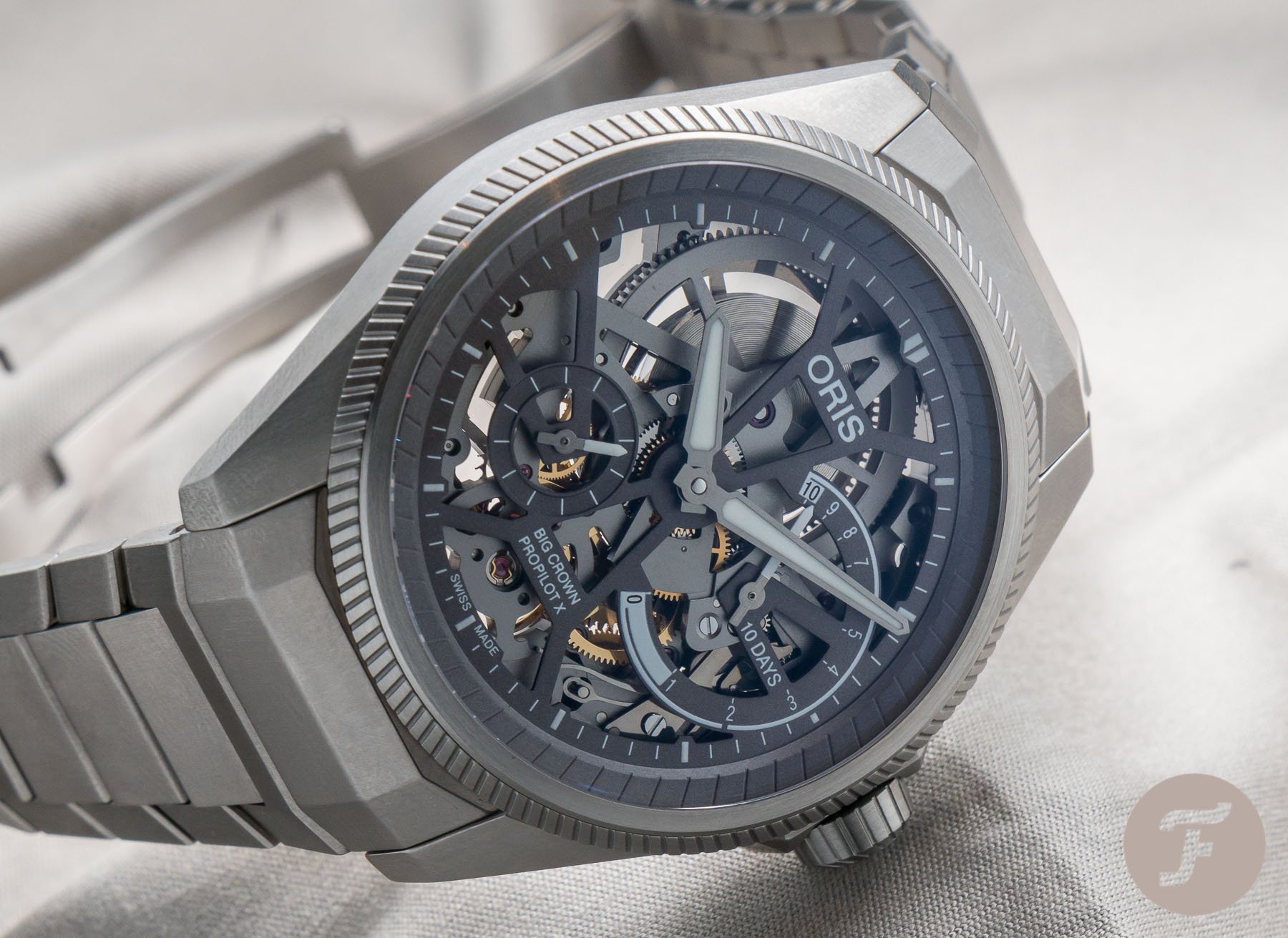
Bracelet
The last part left over for this review is the bracelet. As we have learned from numerous abortive attempts of other brands, designing an attractive bracelet that moreover matches the case of a watch is not an easy task. When I first saw the bracelet of the ProPilot X, I thought that its outer segments could prick the wrist when wearing it. That idea was probably inspired by the pointed corners of those rhomboid-shaped segments. They don’t. But this association demonstrates that I have never worn a watch with a similarly designed bracelet. I am not the benchmark, and I wouldn’t dare to claim that this design is unique. But this shows that this type of bracelet design, at least in this pronounced execution, is rather rare these days. This bracelet not only looks distinctive, but it also looks good. The rather peculiar end links form a convenient transition from the case to the bracelet. Thus we here indeed have a fantastic looking bracelet that even perfectly matches the case, and this results in a successful overall design. Does the bracelet wear comfortably? Definitely! While starting adequately broad where it connects to the case, the bracelet tapers to a relatively slender width at the underside of your wrist. But the extraordinary design still doesn’t end here.
The Clasp
While other brands try and sometimes even manage to hide the lock of a folding clasp completely, Oris presents something utterly extraordinary for the ProPilot X, which they call “lift” folding clasp. You open this clasp by lifting the latch with a fingernail. The engraved “LIFT” on the latch guides everyone to operate this unusual solution correctly. If you wear nail polish (I bet there are even men who do), this might be a bit problematic. This clasp functions reliably. There is a noticeable latching when you close it, and it never accidentally opened while I wore it. I never noticed this clasp while wearing it, which means that it is also comfortable. This design, which reminds of a seat belt latch in an aircraft, Oris has offered before. What is new at the ProPilot X is that the latch is considerably extended laterally. This adaptation is not a functional aspect as it is not necessary for successful operation. It is a purely aesthetic design solution. Maybe this way, the clutch acts as an optical counterbalance to the big case of the watch. Even though this unique solution for the folding clasp adds further icing on the cake design-wise, I still don’t warm to it. But I also needed years to accept and finally even like the massive buckles on Panerai watches.
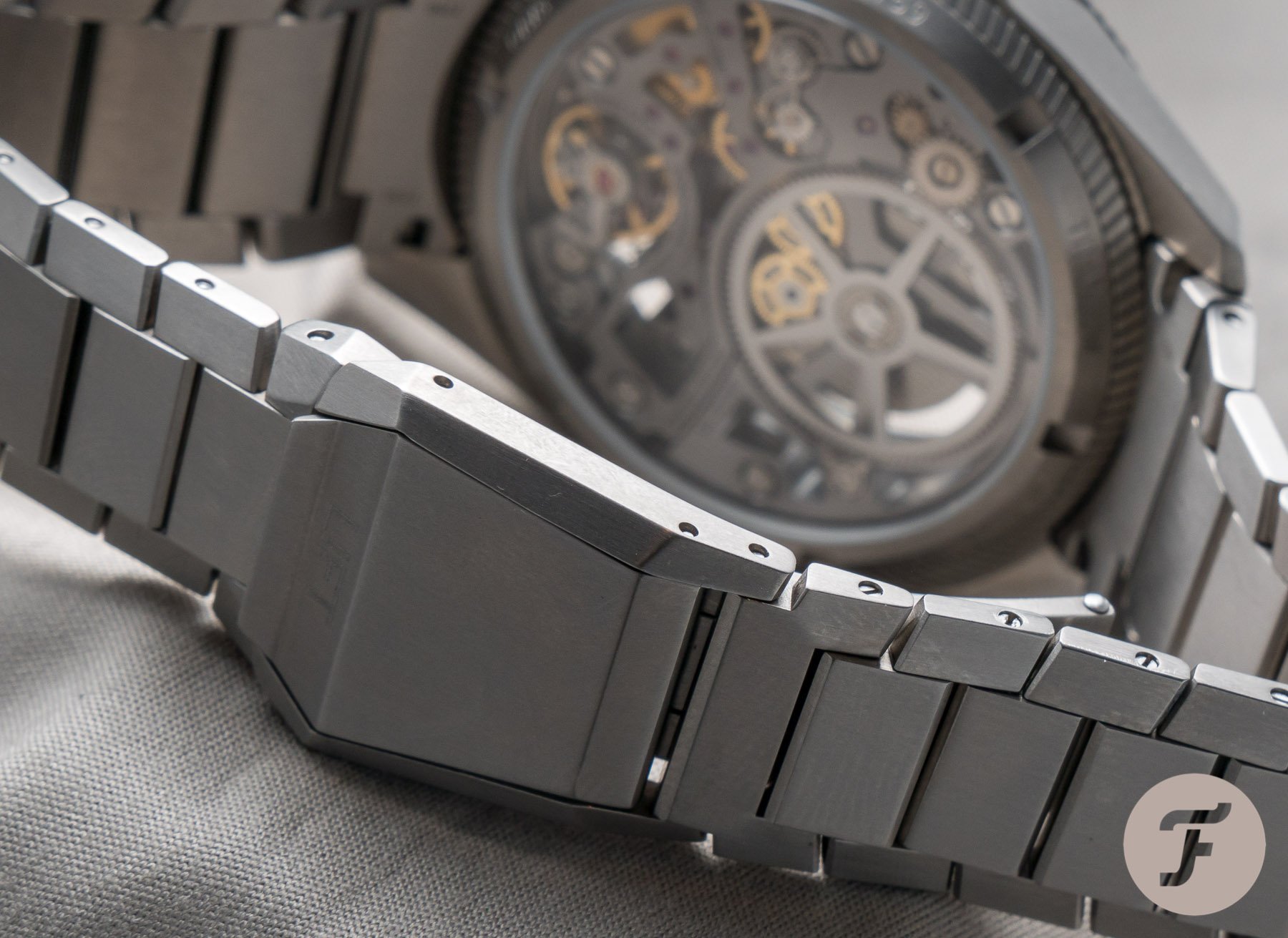
Conclusion
Oris unleash fireworks of original design solutions with the Big Crown ProPilot X Calibre 115. And they wonderfully manage to not only present a collection of great ideas but unite these in one holistic design philosophy. Here the whole is greater than the sum of its parts. And therefore, for me, the ProPilot X, without any doubt, is a new icon of watch design.
The term “icon” is overused for sure. And it seems to be reserved almost entirely for the Audemars Piguet Royal Oak and the Patek Philippe Nautilus. But after decades of worshipping, it should be granted to add another contestant without being considered a heretic.
Is the ProPilot X a true pilot watch? Regarding the requirements defined for this purpose, which are summarised in the ISO 8330, it is not. It is an interpretation of the concept for a future pilot watch and is inspired by that theme.
I don’t want to hear that the ProPilot X is expensive for an Oris. About 7000 hard-earned bucks is a lot of money. For what you receive here (considering the price range of a luxury timepiece), it is a fair offer. And it is presented to you by Oris, an honest company that cares about offering value for money.
To find out more about Oris and their watch collections head for their website.

